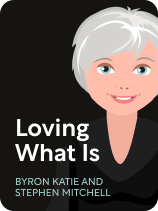

This article is an excerpt from the Shortform book guide to "Loving What Is" by Byron Katie. Shortform has the world's best summaries and analyses of books you should be reading.
Like this article? Sign up for a free trial here.
What are the Loving What Is 4 questions? What is the purpose of each question?
In Loving What Is, Byron Katie recommends asking yourself four questions, which, she claims, will change your life for the better. Specifically, these questions are designed to identify and address distorted and unhelpful thoughts that cloud your judgment and perception of the world.
Let’s explore the purpose of each of these four questions.
#1: Is This an Absolute Truth That I Cannot Disprove?
The purpose of the first of The Loving What Is 4 questions, “Is this an absolute truth that I cannot disprove?” is to search through your memories for at least one piece of evidence that disclaims your statement, revealing it as untrue. According to Katie, your answer should be a simple “yes” or “no.”
Example #1: If you remember at least one time that your children helped you with the chores or showed you respect, the statement, “My children never help with the chores because they don’t respect me,” reveals itself as untrue. Therefore, the answer is “no.”
Example #2: If you remember at least one time you had enough money or felt successful, the statement, “I never have enough money and this makes me feel like a failure,” reveals itself as untrue. Therefore, the answer is “no.”
#2: How Do I Feel and Behave When I Think This Thought?
The purpose of the second question, “How do I feel and behave when I think this thought?” is to list all of the consequences of thinking this thought. This will help you become more conscious of how your thoughts affect your emotions and behaviors. Katie suggests that you consider how thinking this thought influences:
- Your subsequent thoughts and feelings
- How you speak to and behave toward others or react to your circumstances
Example #1: When you think, “My children never help with the chores because they don’t respect me,” you can’t help but think about additional ways your children make your life difficult. This makes you feel resentful and victimized. When you feel like this, your interactions with your children swing between emotional withdrawal and lashing out in anger.
Example #2: When you think, “I never have enough money and this makes me feel like a failure,” your thoughts focus on all of the things you want but can’t have, or on how other people seem to effortlessly get what they want. This makes you feel like your life’s cruel and unfair—and these feelings make you believe that you’re powerless to improve your situation. As a result, you don’t feel motivated enough to take constructive actions, such as creating a budget or opening a savings account, and you let your financial situation devolve.
(Shortform note: If acknowledging the consequences of resistant thoughts inspires self-criticism, remember that the goal of this step isn’t to judge or berate yourself for engaging in negative behaviors, but to increase awareness of how your thoughts influence you. To overcome any self-critical thoughts, focus on self-compassion during this step. For example, you might consciously forgive yourself for any behaviors that inspire feelings of shame or guilt. By shifting your focus from criticism to kindness, you’ll be better able to understand the consequences of your thoughts without falling into the trap of self-defeating thoughts.)
#3: How Does This Thought Benefit Me?
The purpose of the third question, “How does this thought benefit me?” is to reveal that there is no benefit to thinking resistant thoughts. Katie suggests that you consider whether thinking this thought inspires any positive feelings or behaviors that improve your life.
Example #1: The thought, “My children never help with the chores because they don’t respect me,” doesn’t inspire any positive feelings or behaviors that improve your life. Therefore, thinking this thought doesn’t benefit you.
Example #2: The thought, “I never have enough money and this makes me feel like a failure,” doesn’t inspire any positive feelings or behaviors that improve your life. Therefore, thinking this thought doesn’t benefit you.
#4: How Would I Feel and Behave Without This Thought?
The purpose of the fourth question, “How would I feel and behave without this thought?” is to imagine how you’d feel about your situation if this thought had never crossed your mind. This will help you understand that it isn’t the situation that’s making you feel bad. Rather, only this thought about the situation is making you feel bad. Katie suggests that you consider how you’d interpret your situation if you didn’t think this thought, and how this might change the way you feel and behave.
Example #1: Without the thought, “My children never help with the chores because they don’t respect me,” you wouldn’t resent them or focus on how they make your life difficult. Without these resistant thoughts clouding your judgment and emotions, you would find it easier to focus on what’s positive in your family life and enjoy being a parent to your children. And, each time you noticed that the chores hadn’t been done, you’d be able to ask them for help rationally and constructively.
Example #2: Without the thought, “I never have enough money and this makes me feel like a failure,” you would realize that what you have right now is enough to fulfill your needs. You might also notice that it is only your fears about not having enough money in the future that make you feel bad, and decide to train your focus on the present moment to prevent unnecessary anxiety about the future. As a result, you wouldn’t feel any negative emotions about your finances and would find it easier to appreciate what you do have.
| Lateral Thinking Challenges the Influence of Cognitive Biases If you find it difficult to imagine how you’d feel and behave without your resistant thoughts, you may be under the influence of cognitive biases. Biases are the result of your brain’s attempt to make quick judgments based on your past experiences. While there are many different types of cognitive biases, each influencing you in different ways, they all restrict your thoughts to what you know and have experienced—limiting your ability to objectively assess alternative perspectives and feel differently. Lateral thinking methods, such as mind mapping and using Six Thinking Hats, rely on your imagination and restrict the influence of cognitive biases. This is because they employ the creative side of your brain, an area where your biases don’t operate. Consequently, these methods make it easier to break free from resistant thoughts and envision other possibilities. |
| Use Cognitive Behavioral Therapy to Challenge Your Opinions and Beliefs Like Katie, cognitive behavioral therapy (CBT) practitioners argue that the more you question the validity of your thoughts, the less likely you are to get caught up in resistant thoughts and negative emotions. However, the CBT method provides more specific questions to help you objectively examine your thoughts about a situation from multiple perspectives. Answering the following questions in addition to Katie’s four questions will give you a deeper understanding of your beliefs: Facts What evidence is there to support your thoughts about this?What evidence disproves or contradicts your thoughts about this?Are your opinions getting in the way of the facts?Are there any facts that you’ve ignored or overlooked? Other explanations Can you think about this differently?Is your mood impacting the way you’re thinking about this?Have you ever felt differently about this?Are you likely to change your opinion about this over time? Your feelings How does this thought make you feel good?How does this thought make you feel bad?How will you feel if you continue to hold onto this thought? |

———End of Preview———
Like what you just read? Read the rest of the world's best book summary and analysis of Byron Katie's "Loving What Is" at Shortform.
Here's what you'll find in our full Loving What Is summary:
- How to investigate resistant thoughts that trigger emotional discomfort
- A step-by-step process to release resistant thoughts
- How to accept and feel at peace with yourself and others






